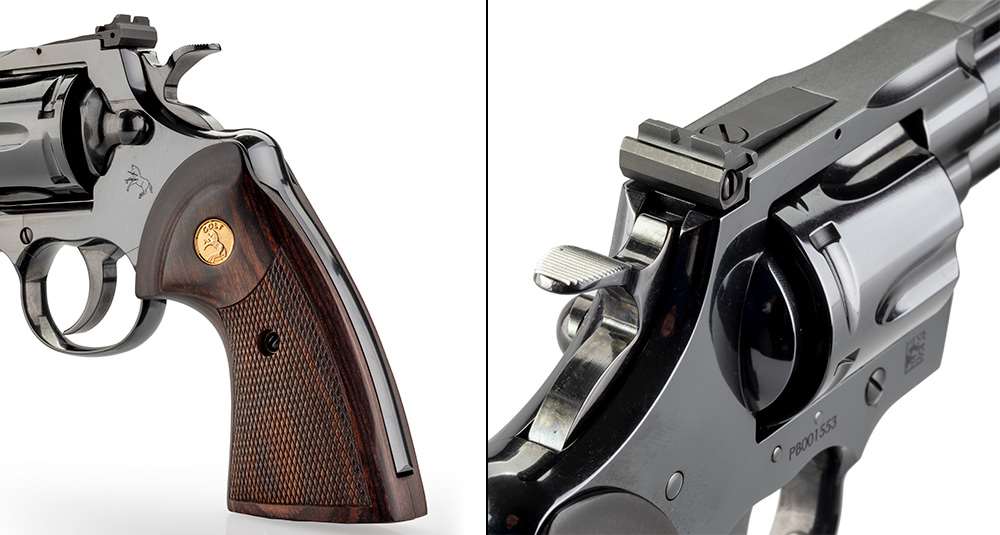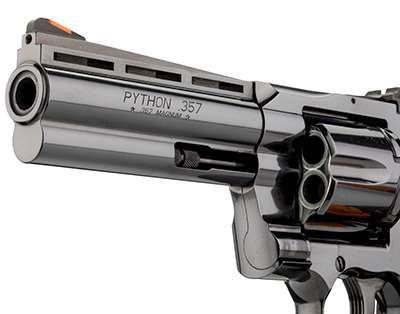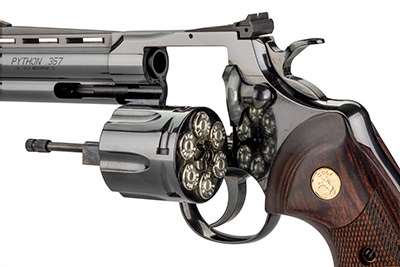The original Colt Python revolver was introduced in 1955 and quickly achieved favor with police officers, competitors and handgun hunters. It remained popular throughout its 50-year production and earned the “iconic” adjective that is often applied to it. The last Pythons had trickled out of Hartford by 2006 after Colt leadership decided it was time for the curtain call.
Its reputation grew in absentia, as did its status as a collector’s item, and the market soon drove Python prices to levels far beyond the budget of the average revolver shooter. The original guns were a reminder of another time; the first Pythons were basically hand-built by the postwar craftsmen employed by Colt in the 1950s. With their applied talent, Pythons became some of the finest revolvers ever produced. While the fitting and polish of those guns approached perfection, the artisans were working with an action that dated to the late 1800s.
It was built predominantly for single-action fire with the low-pressure cartridges of that day, like the fledgling .38 Special. Using the same action in a revolver chambered for the .357 Magnum and meant for double-action operation exposed some weaknesses. The guns were certainly strong enough to handle the pressure, but firing thousands of magnum rounds tended to send Pythons out of time. The double-action trigger also stacked at the end of its travel and made it harder to produce a truly smooth-feeling pull. Back in the day, there were plenty of gunsmiths who could rejuvenate Pythons that had been ridden hard, but, as the years passed, the number of ’smiths working on Colt double-actions dwindled, like the artists who had built them.
Colt returned to the double-action-revolver business with the release of the new Cobra in 2017 and followed up with the King Cobra in 2019. The new guns were well-received, and, by 2020, Colt was ready to put Pythons back into the hands of the faithful. The production team at Colt had fully committed to the project; engineers had studied the shortcomings of the original action and succeeded in both strengthening and simplifying it. The new gun maintained the classic appearance of the Python but came with some major upgrades. The enhanced action was built with fewer components, making it easier and less expensive to produce. The leaf mainspring was maintained, but it was much larger, and its geometry was tweaked. The new gun featured a “cylinder stop” reminiscent of a Smith & Wesson part. The improved lockwork was much stronger and less likely to go out of time; it also gave a superior feeling double-action trigger pull. Action parts (including the hammer, trigger and cylinder release) were machined from bar stock steel.
The thickness of the topstrap was increased by about 30 percent to strengthen the frame in that critical area. The rear sight was reshaped to fit, and the added material was blended to stay true to the original’s appearance. Barrels were forged as one piece from solid billet steel and machined to give the distinctive ventilated rib and full-length underlug. The firing pin was frame-mounted and remained safeguarded with a transfer bar. The trigger was shaped slightly differently from the original and had three shallow grooves running vertically on its face. The hammer was serrated for traction, as was the raised section of the cylinder release. The muzzle end of the rifling was protected by a raised ring around the crown. The front sight was user-removable and secured by a hex-head screw; it was interchangeable with sights made for the Cobra and King Cobra. The stocks were checkered walnut made by Altamont that mimicked the profile of the originals.
The modern Python’s internal lockwork—shown here in the stainless-steel version—has been strengthened and simplified and includes an S&W-style cylinder-stop mechanism (arrow). The red-ramp front sight (l.) paired well with the black-blade rear.
Like the remade “snake” guns that preceded it, the Python was constructed from stainless steel. Attractive and functional, the new guns were embraced by most revolver enthusiasts. But there was the expected gnashing of teeth from those who felt the comeback was incomplete without a blue finish being offered. At the time, most industry gurus predicted that blued Pythons would remain a fond memory of times past, but instead of taking the easy way out, Colt project management chose to honor the customers’ wishes by bringing blued Pythons back in time for the 2024 SHOT Show.
According to Justin Baldini, Colt’s vice president of marketing, the new Pythons are blued in-house using the same formula that’s been in use for at least the 20 years that he’s worked at Colt. The deep, wet look that is often attributed to the bluing process is actually a result of the polishing done prior to the gun being placed in a bluing tank. The “depth” of the finish is a direct result of the level of polishing applied. Carbon-steel Pythons are polished to a “high” level, which is equivalent to the polishing a stainless model receives; new Pythons are not polished to the level of a “bright” finish.
Colt sent me a sample gun for evaluation, and I was pleased that it was the 4.25″-barreled version. The blue Python will initially be offered with 4.25″ and 6″ barrel lengths. When I started in law enforcement in the late 1980s, the 4″ Python was considered the “Cadillac” of duty guns. I’d chosen to carry a 686 and stuck with S&W revolvers, but that doesn’t mean the Python (and some fine officers who carried them) didn’t have an impact on me. I confess to a little excitement as I opened the blue box and removed the Colt from its plastic wrapping.
The fact that I could see my reflection in the bluing of the test gun’s frame made a good first impression. The finish on the blue Python exceeded my expectations—it was deep and flawless—the polishing was executed to a level not often seen on a mass-produced gun. Decision-makers at Colt had to choose how far to pursue the nearly mythical “Royal Blue” of the Python’s past; the more labor dedicated to polishing, the more the MSRP would inevitably rise. Examining the gun, my sense was that the company has struck a good balance.

The blued Python comes with Altamont-made target-style stocks with embedded, gold-tone “Rampant Colt” (l.) emblems. The wide hammer spur is serrated for better purchase during single-action fire.
The Altamont stocks fit the frame well with no uneven seams or gaps. The checkering is cleanly executed, and the Colt emblem is gold-colored—as it should be. Aesthetically, this gun is worthy. Opening the cylinder revealed smooth function of the cylinder-release latch and ejector rod. The lateral lockup was rock-solid on every chamber, and the cylinder had no fore-and-aft movement. The barrel/cylinder gap was minimal and uniform. I was greatly impressed by the lockup on this Colt.
The red-ramp front sight and black-blade rear provide a respectable sight picture. The top of the frame and entirety of the rib are matte-finished to eliminate glare. Dry-firing the Python in double-action mode elicited an approving nod to Colt’s engineers; out of the box, the pull was smooth and non-stacking. Cocking the hammer revealed an excellent, crisp, single-action break with just a whisper of travel before the sear released.
As attractive as the target stocks are, I question whether they were the best choice for shooting a steady diet of full-house magnums. In my experience, covering the backstrap with well-rounded wood or soft rubber is a prudent practice. Some .38 Spl. +P 125-grain JHPs were fired to become familiar with the gun. Recoil was pleasant, and it was still very manageable with Remington Golden Saber .357 Mag. 125-grain (mid-range) JHPs. I finished with several cylinders’ worth of .357 Mag. 125-grain semi-jacketed hollow points that Remington still loads to the cartridge’s full potential; this is the load that helped cement the fabled reputation of the .357 Mag. as a top-tier defensive cartridge. Along with the power, it’s known for stiff muzzle blast and sharp recoil—not an easy round to shoot well from a service gun.

The blued Python’s barrel retains the same vent rib, full underlug and raised crown found on the stainless-steel versions of the gun.
The discomfort I was expecting from the heavy loads didn’t occur. The shape of the grip frame and the muzzle-heavy balance helped curb felt recoil. Instead of painfully driving the force straight back into the web of the hand, the Python’s backstrap was more forgiving. If I relaxed my grasp during long strings, the gun would roll up in my hand, like a Single Action Army, but on a lesser scale. Keeping tension on the base of the stocks prevented me from having to adjust my grip. When ejecting magnum cases, empties would occasionally catch on the top edge of the left-side stock, but concentrating on clean technique and keeping the gun vertical minimized this. The top of the ejector rod was well-shaped for solid “palm strikes” to help clear empty cases.
I measured velocities while firing groups from an informal bench rest. The Colt’s double-action pull was smooth enough that there was no discernible difference in group sizes shooting single- or double-action—a testament to the work done on the inside. The groups recorded were a good indication of field accuracy: my “rest” was a stadium seat cushion on a small desk left on the range. When Wiley Clapp previously covered the stainless-steel Python, he compiled accuracy data on old and new Pythons with a Ransom Rest. His article is an excellent reference for what these guns are capable of when the human element is removed.
The rifling’s 1:14″ twist worked well with the 125- and 130-grain bullets initially fired but seemed to favor the 158-grain Federal JSPs at 25 yards. I made a minor sight adjustment to bring vertical point of impact onto point of aim with the heavier bullet. The Python had been printing slightly, but consistently, left, so I also made a windage correction. The re-designed rear sight gave positive tactile “click” adjustments with the elevation screw. To facilitate windage adjustment, a hex-head locking screw had to be loosened first. The rear sight blade could then be moved laterally with a smaller, standard-blade screwdriver. The sight was solid and well-designed; the set screw never worked itself loose in recoil. Colt thoughtfully used the same size screw (.050 hex) for this part as the one securing the front sight. That wrench and a few properly sized screwdrivers need to be kept in the range bag for sight adjustment and for removing the stocks and cylinder.

Pulling back on the Python’s cylinder release allows the fluted cylinder to be loaded with six .357 Mag.—or .38 Spl.—cartridges, and a knurled ejector rod tip helps remove fired cases.
I paced back to the 50-yard line and assumed a prone position, the cylinder loaded with the Federal 158s. Six rounds were fired double-action at an IDPA silhouette target as rapidly as I could acquire a good sight picture. The Python rewarded me with a group that impacted where the sights were held that measured 4.55″ vertically and 1.85″ in width. Superimposing a B27 repair center on the silhouette, the highest round of the group would have just clipped the top of the 10″ ring. I understood then why people screwed Python barrels onto their S&W and Ruger frames for PPC shooting back in the ’70s. This gun proved capable of cleaning the 50-yard prone portion of a PPC course—with magnum ammo.
On another trip, the Python salvaged what would otherwise have been a pretty miserable weather day. My son was home on leave, and we’d journeyed to the range to shoot rifles. The winds increased to near gale force on our commute and made short work of our rifle mission. We ended up ringing steel targets from 10 to 50 yards distant with the Python and having a blast. My son’s job in the Marine Corps mandates regular training and qualification with the SIG Sauer M18. Although his recent handgun experience is with semi-automatics, he was impressed with the double-action trigger on the Python and shot it very effectively.
At that point, the Python had consumed nearly 300 rounds of ammunition without issue. Maintenance had consisted of brushing under the extractor after about 200 rounds fired. The muzzle end of the revolver wore a thin brown coat of carbon fouling extending an inch rearward—it had earned a cleaning. The highly polished surfaces helped; crud came off easily. Removing the stocks revealed the snug internal fit and locator pins used by Altamont. This explained the total lack of shifting or wiggle experienced with the stocks.
I ran through the Rangemaster Defensive Revolver Qualification, pressing a holster and HKS speedloaders made for an S&W 686 into service. The Python did its part, shooting a 100 percent score—I was the weak link, being slightly over time on two early stages. I then shot every example of .357 Mag. defensive ammunition I could lay hands on with bullet weights ranging from 100 to 158 grains. Considering its duty-length barrel, the Python produced impressive velocities with nearly all the loads fired. Full-house 125-grain JHPs reached 1,450-1,500 f.p.s. Colt Defense-branded 158-grain JHPs (made by DoubleTap) were particularly eye-opening with an average velocity of 1,420 f.p.s. and a standard deviation of only 15.

A couple of heavyweight hard-cast bullets were also fired over the chronograph. DoubleTap’s 180-grain Hard Cast Solid averaged 1,311 f.p.s. (Sd 25) and, by some ballistic sorcery, hit to the 158-grain zero. Corbon’s 200-grain HC ran 1,111 f.p.s. on average with an Sd of 12. Both yielded excellent accuracy and would provide deep, straight-line penetration—if the Python were used for medium-game hunting or large-predator defense, these rounds would be up to the task. I finished the day shooting a box of .38 Spl. match wadcutters from various ranges; that was enjoyable to the point of being therapeutic. My initial concerns that the grooved trigger would abrade a trigger finger were unjustified; even with some high-round-count shooting sessions, the grooves caused no pain.
I cleaned the Python again, and it refused to show wear with 459 rounds fired—251 of them magnums. The bluing showed the slightest discoloration on the recoil shield where it engaged the back of the cylinder. Otherwise, the gun could pass for new: There was no visible turn line between the cylinder stop notch relief cuts, and the lock-up was still tight with absolutely no discernible endshake. The trigger felt even better than when the gun was new.
The folks at Colt have embraced technology and modern machining methods to make the new Python stronger and more durable than the original. Doing so also allowed them to keep the price at a reasonable level. If it were mine, I’d swap the red-ramp front sight for an available fiber-optic, brass-bead or tritium unit to accommodate aging eyesight, and Colt made that easy to do. I wouldn’t change anything else about this gun. It’s the perfect size and weight for the .357 Mag. cartridge; it’s accurate, reliable and extremely handsome. As it should be—it’s a Python.

Read the full article here

